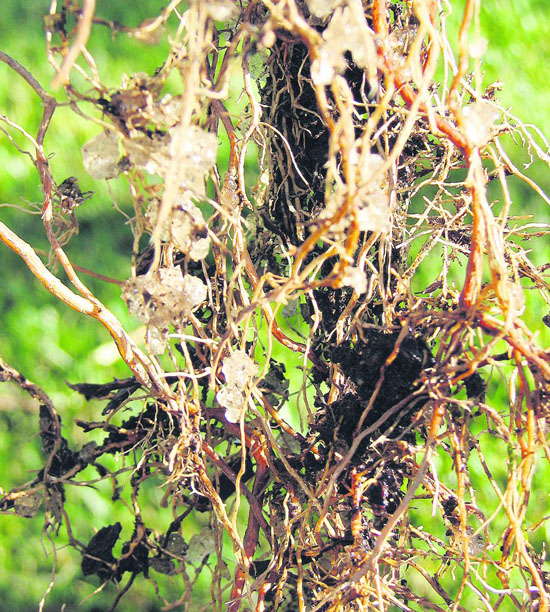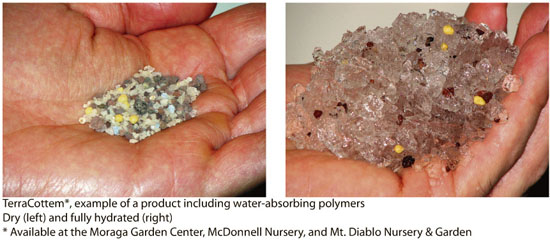| | Published September 3, 2008
| Water-Smart Gardening in Times of Drought
| | By Raf Lambrecht |  | | Geranium roots showing growth into the water-holding polymers
Photo by Raf Lambrecht
|
The current drought and water-use restrictions don't mean you now have to feel guilty about gardening. You probably already use some of the most obvious ways to save water. For instance, you made smart choices of plants and you maintain most of your plants on a leak-free drip system; you water the lawn early in the morning and set the timer short enough to avoid runoff; you have a layer of mulch or bark to keep the soil underneath cool and moist. In other words, you are efficiently delivering water to the soil and are keeping evaporation limited. What about using the water more efficiently once it's in the soil? Lava, mineral products like vermiculite and perlite, together with compost and peat moss improve soil aeration, create better drainage, and hold some water. However, water-absorbing polymers create water savings far beyond those of porous minerals and compost. When mixed into the soil, these polymers act like high-capacity sponges; they retain water and dissolved nutrients in mini-reservoirs around the roots of the plant, so the plant has access to it whenever needed. Water-absorbing polymers are available in several commercial products. They are based on polyacrylamide, a product that is approved for use in agriculture and home gardening. When choosing water-absorbing polymers, it is important to confirm that the polymers not only hold large amounts of water, but also release it easily to the plant roots when needed. Some of the products are combined with fertilizer and/or additional plant nutrients and various other components. Your local nurseryman can advise you on the characteristics and value of these products.
Plants grown in soil mixed with polymers will develop roots growing into the watery gel clumps, thus creating their own protection against drought. The plants will still transpire the water that their roots pull from the mini water reservoirs; so watering remains necessary. However, it's easy to cut watering in half. In addition, dissolved fertilizers will be held available in the water-reservoirs until absorbed by the plants. Thus, along with minimizing the amount of water, fertilizers will also be used more efficiently. The water-absorbing polymers have also shown to attract healthy bacteria and other microbial activity in the soil, which stimulates plant development. Water-absorbing polymers can be used in all seasons for all forms of planting (lawns, flowerbeds, vegetable gardens, shrubs, trees, grapevines, and container plants). They represent a small investment that pays back itself in water savings many times over. Polyacrylamide polymers are slowly biodegradable and stable for many years. They support sustainable landscaping with minimal impact on the environment by saving water and minimizing fertilizer run-off.
Products with water-absorbing polymers have been used by the Moraga Parks Department and in local garden. Ken Murakami, owner of the Moraga Garden Center, uses such products in his container plants, especially for hanging baskets. He agrees it's a good tool "to help the nurserymen and their customers in California, where we live in a perpetual state of drought."
|
 | | Raf and Marleen Lambrecht are the owners of Better Soil Company, based in Moraga. They are proud supporters of Professor Van Cotthem's research work with polymers used for desertification and horticulture. Their goal is "to create greater awareness for the possibilities of this modern technology and to save California's water, one garden at a time."
www.bettersoil.com, (925) 631 9157.
|  | | | | | | Advertisement | | |
| | | | | | Comments | | | | | | | | | | | | | | | Subscribe / Unsubscribe | | | | | |
| | | | | |  | | |
| | |  | | |
| | | | | |

